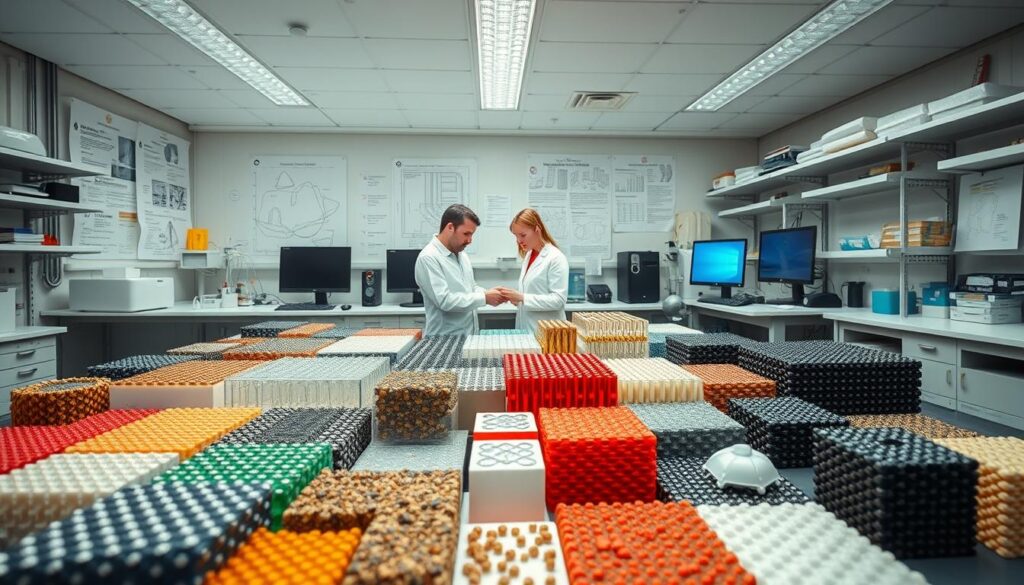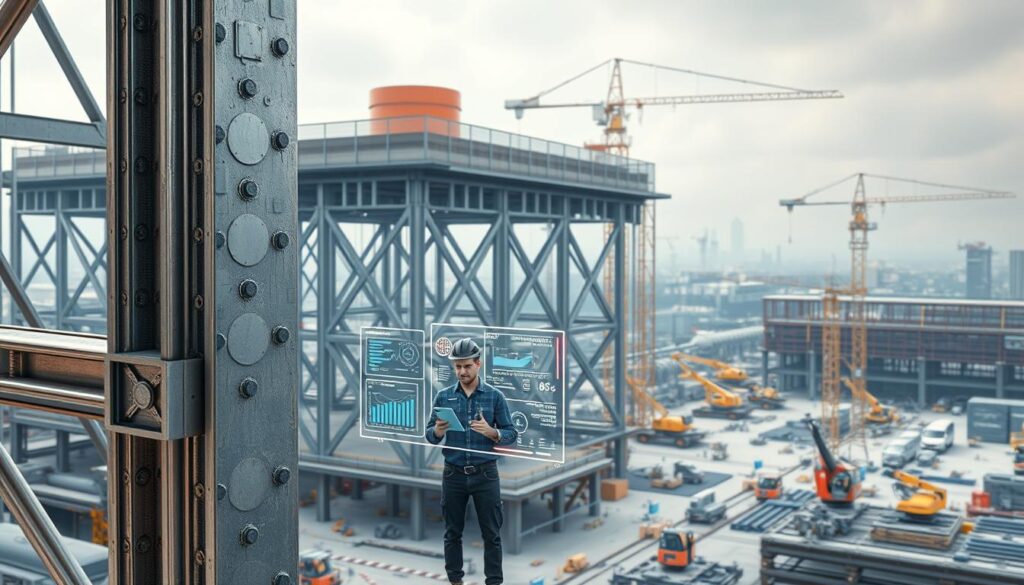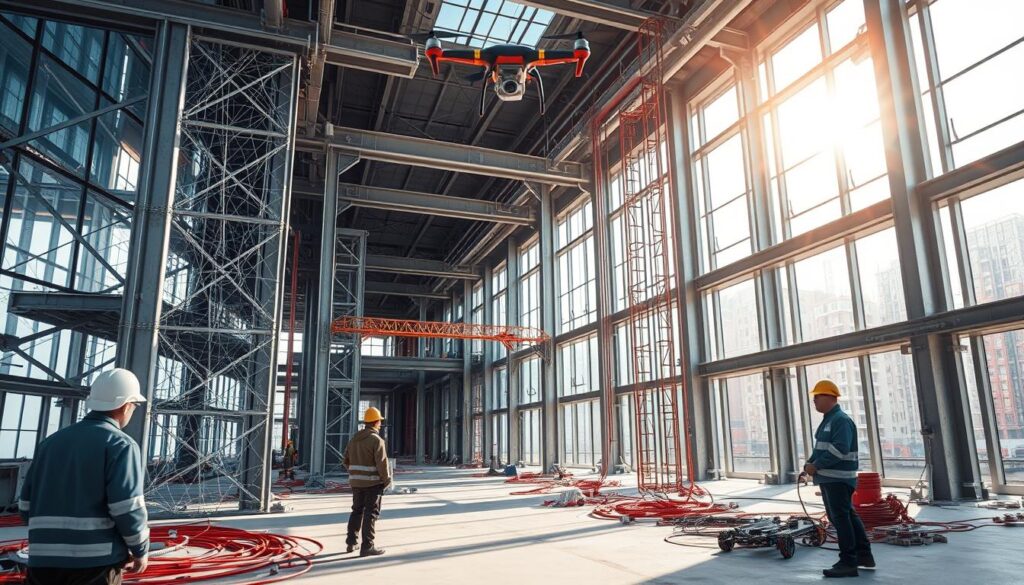The construction industry is on the cusp of a revolution, driven by the advent of advanced construction materials that are transforming the way we design and build structures. Did you know that buildings account for nearly 40% of global energy consumption? Innovative construction materials are changing this narrative by enabling the creation of energy-efficient, sustainable, and resilient buildings.
These innovative materials possess unique properties that allow them to respond to external stimuli, adapting and changing their properties as needed. For instance, a recent article on LinkedIn highlights the potential of self-healing concrete and automated window shading systems, which can significantly improve a building’s energy efficiency and reduce maintenance needs.
Key Takeaways
- Advanced construction materials are revolutionizing the industry by enabling energy-efficient and sustainable buildings.
- Innovative materials like self-healing concrete can repair cracks autonomously, reducing maintenance needs.
- Automated window shading systems can control solar gain and heat loss, improving energy efficiency.
- The use of smart materials can lead to reduced repair costs and increased resilience of buildings.
- These materials are transforming the construction industry by providing new design and building possibilities.
Introduction to Smart Materials in Construction
As the construction industry evolves, smart materials are emerging as a key factor in creating more resilient, efficient, and sustainable buildings. These innovative materials are designed to improve the performance and longevity of structures, making them an integral part of modern construction practices.
What Are Smart Materials?
Smart materials are substances that can respond to external stimuli, such as temperature or light, by changing their properties. This unique ability allows them to be used in a variety of applications, from self-healing materials to energy-harvesting technologies. For instance, smart materials can be integrated into building designs to enhance their durability and reduce maintenance costs.
The use of smart materials in construction is not limited to a single type; they encompass a broad range of materials, including shape memory alloys, electrically active polymers, and phase change materials. Each of these materials has its own set of characteristics that make it suitable for specific applications in the construction industry.
Importance of Smart Materials in Modern Construction
The importance of smart materials in modern construction cannot be overstated. They contribute significantly to making buildings more sustainable, energy-efficient, and cost-effective. By incorporating smart materials into building designs, architects and engineers can create structures that not only meet but exceed current sustainability standards.
One of the key benefits of smart materials is their ability to enhance the energy efficiency of buildings. For example, phase change materials can absorb and release heat, reducing the need for heating and cooling systems. This not only lowers energy consumption but also decreases the carbon footprint of the building.
| Type of Smart Material | Application in Construction | Benefits |
|---|---|---|
| Shape Memory Alloys | Self-healing materials, seismic-resistant structures | Enhanced durability, reduced maintenance |
| Electrically Active Polymers | Energy harvesting, adaptive building facades | Increased energy efficiency, improved aesthetics |
| Phase Change Materials | Thermal energy storage, building insulation | Reduced energy consumption, lower carbon footprint |
The integration of smart materials into construction projects is a significant step towards achieving sustainability and efficiency in the built environment. As the industry continues to evolve, the role of smart materials is expected to become even more prominent, driving innovation and excellence in building design and construction.
Types of Smart Materials Used in Construction

Cutting-edge construction materials, such as smart materials, are changing the face of modern construction. The incorporation of innovative construction materials into building design is not only enhancing the aesthetic appeal of structures but also improving their functionality and sustainability.
Smart materials are designed to respond to environmental stimuli, making them highly versatile for various applications in construction. These materials include shape memory alloys, electrically active polymers, and phase change materials, each offering unique properties that can be leveraged to achieve specific construction goals.
Shape Memory Alloys
Shape memory alloys (SMAs) are a class of smart materials that can return to their original shape after being deformed upon heating. This property makes them particularly useful for applications in seismic-resistant design, where they can absorb and dissipate energy during an earthquake.
For more information on the applications of shape memory alloys in construction, visit The Constructor for detailed insights.
Electrically Active Polymers
Electrically active polymers (EAPs) are another type of smart material that can change shape or size when stimulated by an electric field. This characteristic makes them suitable for use in advanced actuators and sensors within building structures.
Phase Change Materials
Phase change materials (PCMs) are substances that can store and release thermal energy as they change phase from solid to liquid or vice versa. Incorporating PCMs into building envelopes can help regulate indoor temperatures, reducing the need for heating and cooling systems.
For a deeper dive into sustainable building materials, including eco-friendly construction materials, check out World Civil Society for comprehensive resources.
| Smart Material | Properties | Applications |
|---|---|---|
| Shape Memory Alloys | Can return to original shape upon heating | Seismic-resistant design, actuators |
| Electrically Active Polymers | Change shape or size with electric field | Advanced actuators, sensors |
| Phase Change Materials | Store and release thermal energy | Thermal energy storage, building envelopes |
“The integration of smart materials into construction represents a significant step forward in creating more sustainable, resilient, and adaptive buildings.” – Expert in Sustainable Construction
The Benefits of Incorporating Smart Materials
The integration of smart materials in construction projects has revolutionized the industry by offering numerous benefits. These advanced materials are designed to improve the performance, sustainability, and cost-effectiveness of buildings.
Enhanced Durability and Longevity
One of the primary advantages of smart materials is their ability to enhance the durability and longevity of structures. Shape Memory Alloys (SMAs), for instance, can withstand extreme temperatures and return to their original shape, reducing the need for frequent repairs.
The use of SMAs in seismic-resistant buildings has shown significant promise. These alloys can absorb and dissipate energy, thereby reducing the impact of earthquakes on structures.
Energy Efficiency and Sustainability
Smart materials also contribute to energy efficiency and sustainability in construction. Phase Change Materials (PCMs), for example, can absorb and release heat, reducing the need for heating and cooling systems.
| Material | Energy Saving Potential | Sustainability Benefits |
|---|---|---|
| Phase Change Materials | Up to 30% reduction in energy consumption | Reduced carbon footprint |
| Electrically Active Polymers | Improved energy harvesting capabilities | Enhanced building facades |
Cost-Effectiveness in Construction Projects
The incorporation of smart materials can lead to significant cost savings in construction projects. While the initial investment may be higher, the long-term benefits, including reduced maintenance and energy costs, outweigh the upfront expenses.
A notable example is the use of smart windows that can adjust their tint in response to changing light conditions, thereby reducing the need for artificial lighting and air conditioning.
By adopting smart construction solutions, builders and architects can create structures that are not only sustainable and energy-efficient but also cost-effective in the long run.
How Smart Materials Work

Understanding how smart materials work is crucial for unlocking their potential in construction projects. These materials operate through various mechanisms, including shape-memory effects and sensor-activated responses.
Mechanisms Behind Shape Memory Alloys
Shape Memory Alloys (SMAs) are a class of intelligent building materials that can return to their original shape after deformation upon exposure to a specific temperature. This property is known as the shape-memory effect. SMAs are used in construction for applications such as seismic-resistant structures and adaptive building components.
The mechanism behind SMAs involves a phase transformation between martensite and austenite. When an SMA is deformed in its martensitic state, it can recover its original shape by transforming back to austenite upon heating. This unique property makes SMAs valuable for smart construction technology, enabling the creation of structures that can adapt to environmental changes.
The Role of Sensors in Smart Materials
Sensors play a critical role in innovative construction materials by enabling real-time monitoring of structural health and environmental conditions. These sensors can detect changes in temperature, strain, and other factors, allowing for immediate responses to maintain structural integrity.
The integration of sensors with smart materials facilitates the development of intelligent systems that can predict and prevent potential failures. For instance, sensors embedded in concrete can monitor stress levels, providing early warnings of potential cracks or structural weaknesses.
By understanding the mechanisms behind shape-memory alloys and the role of sensors, we can harness the full potential of smart materials in construction. This knowledge enables the development of more resilient, adaptive, and sustainable buildings, marking a significant step forward in smart construction technology.
Applications of Smart Materials in Building Design
Cutting-edge construction materials are being utilized in various aspects of building design to enhance sustainability and efficiency. Smart materials are revolutionizing the construction industry by providing innovative solutions for building design, making structures more adaptable, sustainable, and efficient.
The integration of smart construction solutions in building design is not only enhancing the aesthetic appeal of buildings but also improving their functionality and reducing environmental impact. These materials are being applied in various ways, including structural health monitoring systems, energy harvesting technologies, and adaptive building facades.
Structural Health Monitoring Systems
One of the critical applications of smart materials is in structural health monitoring systems. These systems use sensors made from smart materials to monitor the condition of buildings in real-time, detecting potential issues before they become major problems. This proactive approach to maintenance can significantly extend the lifespan of a building and reduce maintenance costs.
For instance, fiber optic sensors can be integrated into the structure of a building to monitor strain and temperature. These sensors can detect even slight changes in the building’s condition, allowing for early intervention.
| Technology | Application | Benefits |
|---|---|---|
| Fiber Optic Sensors | Strain and Temperature Monitoring | Early detection of potential issues, reduced maintenance costs |
| Piezoelectric Sensors | Vibration Monitoring | Improved structural health monitoring, enhanced safety |
Energy Harvesting Technologies
Energy harvesting technologies are another significant application of smart materials in building design. These technologies involve capturing and converting environmental energy into electrical energy, which can then be used to power various systems within the building.
For example, piezoelectric materials can be used to generate electricity from mechanical stress, such as vibrations or footsteps. This energy can be used to power lighting systems, sensors, and other low-power devices.
Adaptive Building Facades
Adaptive building facades are a cutting-edge application of smart materials, allowing buildings to respond to changing environmental conditions. These facades can adjust their properties to optimize energy efficiency, reduce glare, and enhance occupant comfort.
For instance, electrochromic glass can change its tint in response to light conditions, reducing the need for artificial lighting and minimizing heat gain. This not only improves the energy efficiency of the building but also enhances the comfort of its occupants.
In conclusion, the applications of smart materials in building design are vast and varied, offering numerous benefits in terms of sustainability, efficiency, and functionality. As the construction industry continues to evolve, the use of eco-friendly construction materials and smart construction solutions is expected to become even more prevalent.
Case Studies of Smart Materials in Action

Several pioneering construction projects have successfully utilized smart materials, demonstrating their benefits and challenges. These case studies provide valuable insights into the practical applications and potential of smart materials in the construction industry.
Notable Projects Using Smart Materials
One notable example is the use of shape memory alloys in seismic retrofitting projects. For instance, a study published in IOP Science highlights the application of shape memory alloys in enhancing the structural integrity of buildings during earthquakes.
The benefits of using advanced construction materials like shape memory alloys include enhanced durability and the ability to withstand extreme conditions. Such materials are paving the way for innovative construction materials that can adapt to various environmental factors.
- The Solar Ark in Japan, which incorporates advanced photovoltaic systems.
- The VanDusen Botanical Garden Visitor Centre in Canada, featuring a living roof and sustainable building practices.
- The One Central Park in Sydney, Australia, with its innovative use of sustainable construction materials and energy-efficient systems.
Lessons Learned from Successful Implementations
The successful implementation of smart materials in these projects has provided several key lessons. Firstly, the importance of integrating innovative construction materials with traditional building practices to achieve optimal results. Secondly, the need for ongoing research and development to improve the performance and cost-effectiveness of smart materials.
- Collaboration between industry stakeholders and researchers is crucial for advancing the field.
- The use of smart materials can significantly enhance the sustainability and efficiency of construction projects.
- Careful planning and execution are necessary to overcome the challenges associated with new materials.
By examining these case studies, we can gain a deeper understanding of how advanced construction materials are transforming the construction industry and identify opportunities for future innovation.
Challenges in Implementing Smart Materials
Despite their benefits, smart materials face several obstacles in widespread adoption. The construction industry’s enthusiasm for smart construction technology is tempered by practical challenges that need to be addressed for successful implementation.
The first major hurdle is the high initial costs associated with eco-friendly construction materials and cutting-edge technologies. While these materials offer long-term savings and benefits, their initial investment costs can be prohibitively expensive for many projects.
High Initial Costs
The high upfront costs of smart materials can deter construction companies from adopting these technologies. For instance, cutting-edge construction materials often require specialized manufacturing processes, increasing their cost.
| Material | Traditional Cost | Smart Material Cost |
|---|---|---|
| Concrete | $100/ton | $150/ton |
| Steel | $500/ton | $700/ton |
| Glass | $200/m2 | $300/m2 |
For more insights on the challenges faced by smart building projects, visit Ricardo Vargas’s article on the barriers and challenges in the context of Construction 4.0.
Research and Development Limitations
Another significant challenge is the limitation in research and development. The field of smart materials is rapidly evolving, and there is a need for continuous innovation to improve their performance and reduce costs.
Addressing these challenges will be crucial for the widespread adoption of smart materials in the construction industry. It requires a collaborative effort from manufacturers, researchers, and industry stakeholders to overcome the current limitations and make these materials more accessible and affordable.
Innovations in Smart Material Technologies

Recent breakthroughs in material science are paving the way for advanced smart materials in construction. These innovations are not only enhancing the performance of building materials but also opening up new possibilities for the construction industry.
The development of innovative construction materials is a key area of focus. Researchers are continually exploring new materials with unique properties that can be integrated into construction projects. For instance, the use of shape memory alloys has shown significant promise in creating structures that can adapt to different conditions.
Recent Advances in Material Science
Material science has seen significant advancements in recent years, leading to the development of advanced construction materials. These materials are designed to provide improved durability, sustainability, and functionality. One notable example is the development of self-healing materials that can repair cracks and damages autonomously.
Another area of research is in electrically active polymers, which can be used to create adaptive building facades that respond to environmental changes. These polymers can alter their shape or properties in response to electrical stimuli, offering new possibilities for energy-efficient building designs.
Future Trends in Smart Materials
Looking ahead, the future of intelligent building materials is expected to be shaped by several key trends. One of the most significant trends is the integration of nanotechnology in material science. This involves manipulating materials at the nanoscale to create materials with enhanced properties.
For more information on the latest technologies in construction, visit World Civil Society to explore how smart materials are being used in bridge construction and other infrastructure projects.
The construction industry is poised to benefit greatly from these innovations, with potential applications in creating more sustainable, durable, and adaptive structures. As research continues to advance, we can expect to see even more exciting developments in the field of smart materials.
Regulatory Considerations for Smart Materials
As smart materials become more prevalent in construction, understanding regulatory considerations is essential. The integration of these materials into building projects is subject to various regulatory frameworks that ensure safety, compliance, and efficiency.
Safety Standards and Compliance
Safety standards are a critical aspect of regulatory considerations for smart materials. These standards are designed to protect users and ensure that materials perform as expected under various conditions. Compliance with safety standards is not only a legal requirement but also a moral obligation for manufacturers and builders.
Key safety considerations include:
- Material durability and longevity
- Resistance to environmental factors such as temperature and humidity
- Compatibility with other building materials
Ensuring compliance with these standards involves rigorous testing and certification processes. Manufacturers must work closely with regulatory bodies to ensure that their products meet all necessary safety requirements.
Building Codes and Smart Technology
Building codes play a significant role in the adoption of smart materials in construction. These codes dictate how buildings should be designed and constructed to ensure safety and efficiency. As smart materials and technologies evolve, building codes must be updated to accommodate these innovations.
The integration of smart technology into building codes involves:
- Updating existing codes to include provisions for smart materials
- Developing new standards for emerging smart technologies
- Ensuring that smart materials are used in a way that enhances building performance and safety
By navigating these regulatory considerations, the construction industry can fully leverage the benefits of smart materials, including enhanced sustainability, improved safety, and increased efficiency.
Smart Materials and Sustainability

Smart materials are at the forefront of enhancing sustainability in the construction industry. These innovative materials are designed to provide eco-friendly construction materials that not only reduce environmental impact but also improve the efficiency of buildings.
Environment-Friendly Solutions
One of the significant advantages of smart materials is their ability to offer environment-friendly solutions. For instance, self-healing materials can repair cracks autonomously, reducing the need for maintenance and the environmental impact associated with repair materials.
As noted by experts, “The use of smart materials in construction can significantly reduce the environmental footprint of buildings.” (Learn more about smart materials for).
Reducing Carbon Footprint in Construction
Smart materials play a crucial role in reducing the carbon footprint of construction projects. Sustainable construction materials such as phase change materials can help regulate indoor temperatures, reducing the need for heating and cooling systems and thereby lowering energy consumption.
- Energy-efficient solutions through advanced material technologies.
- Reduced material waste due to self-healing properties.
- Lower energy consumption through improved building envelopes.
By incorporating green construction materials into building designs, architects and builders can create structures that are not only sustainable but also resilient and adaptable to changing environmental conditions.
The Role of Smart Materials in Disaster Resistance
The role of smart materials in enhancing the resilience of buildings to disasters is becoming increasingly important. As natural disasters like earthquakes and floods continue to pose significant threats to structures worldwide, the construction industry is turning to innovative construction materials to improve disaster resistance.
Smart materials, with their ability to adapt and respond to external forces, are at the forefront of this shift towards disaster-resistant construction. These advanced construction materials can significantly enhance the safety and durability of buildings, reducing the risk of damage during disasters.
Earthquake-Resistant Structures
One of the critical applications of smart materials is in the development of earthquake-resistant structures. Shape Memory Alloys (SMAs), for instance, can be integrated into building frames to provide seismic resistance. These alloys can absorb and dissipate the energy generated by earthquakes, thereby reducing the stress on the structure.
“The use of SMAs in seismic design represents a significant advancement in earthquake-resistant construction.” By leveraging the unique properties of SMAs, engineers can create buildings that not only withstand earthquakes but also recover their original shape after the seismic event, minimizing the need for costly repairs.
Flood-Resistant Building Designs
In addition to earthquake resistance, smart materials are also being utilized to enhance flood resistance in building designs. Advanced materials like electrically active polymers can be used to create adaptive building facades that respond to changing water levels. These facades can adjust their permeability or change their structure to prevent water ingress during floods.
The incorporation of such innovative construction materials into building design not only enhances the structure’s ability to withstand floods but also contributes to the overall sustainability of the construction project by reducing the need for extensive repairs or reconstruction.
As the construction industry continues to evolve, the integration of smart materials into disaster-resistant designs is expected to play a crucial role in creating more resilient and sustainable buildings. By adopting these advanced construction materials, builders can significantly improve the disaster resistance of their projects, ultimately saving lives and reducing economic losses.
“The future of disaster-resistant construction lies in the continued development and application of smart materials.”
Collaboration in Smart Materials Development

The future of smart materials in construction relies heavily on collaborative development. As the industry continues to evolve, it’s becoming increasingly clear that no single entity can drive innovation alone.
Collaboration between industry partners, research institutions, and universities is crucial for advancing smart construction technology and advanced construction materials. By working together, these stakeholders can pool their resources, expertise, and knowledge to develop innovative solutions that might not be achievable independently.
Industry Partnerships and Research Collaborations
Industry partnerships play a vital role in the development and commercialization of smart materials. By collaborating with research institutions, companies can stay at the forefront of collaborative research and ensure that new technologies are practical and applicable.
| Industry Partner | Research Focus | Outcome |
|---|---|---|
| Company A | Shape Memory Alloys | Enhanced seismic resistance |
| Company B | Electrically Active Polymers | Improved energy harvesting |
| Company C | Phase Change Materials | Increased energy efficiency |
University Contributions to Smart Material Research
Universities are pivotal in advancing the field of smart materials through fundamental research and the development of new technologies. Their contributions often lay the groundwork for future innovations in smart construction technology.
By fostering a collaborative environment, universities, industry partners, and research institutions can accelerate the development and adoption of smart materials. This synergy is essential for overcoming the challenges associated with integrating these advanced materials into construction projects.
The importance of collaboration in smart materials development cannot be overstated. As the construction industry continues to embrace these innovative materials, the need for continued collaboration will only grow.
The Future of Smart Materials in Construction
The future of construction is being rewritten by the advent of smart materials, promising enhanced sustainability and efficiency. As these materials continue to evolve, they are expected to have a profound impact on the construction industry.
Predictions for Smart Material Evolution
Advancements in material science are anticipated to drive the development of new smart materials with enhanced properties. These materials are likely to be more durable, sustainable, and adaptable to various construction needs.
Innovative properties such as self-healing materials and advanced energy harvesting technologies are expected to become more prevalent. This will not only improve the functionality of buildings but also contribute to sustainable construction practices.
Long-Term Impact on the Construction Industry
The long-term impact of smart materials on the construction industry is expected to be significant. With their ability to enhance durability and reduce maintenance needs, smart materials will likely become a staple in modern construction projects.
- Improved energy efficiency through advanced materials
- Enhanced structural integrity and safety
- Increased sustainability through recyclable and adaptable materials
As the industry continues to adopt these innovative materials, we can expect to see a shift towards more sustainable and efficient construction practices. The future of smart materials in construction is bright, and their potential to transform the industry is vast.
Conclusion: The Promise of Smart Materials in Construction
Smart materials are revolutionizing the construction industry by offering numerous benefits, including enhanced durability, energy efficiency, and sustainability. These innovative materials have the potential to transform the way buildings are designed, constructed, and operated.
Key Benefits
The incorporation of smart materials in construction projects can lead to significant improvements in building performance and reduced maintenance costs. Sustainable construction materials, such as shape memory alloys and phase change materials, are being increasingly used to create energy-efficient buildings.
Industry Adoption
To fully realize the potential of smart construction solutions, industry-wide adoption is crucial. By embracing these innovative materials and technologies, construction professionals can create more sustainable, resilient, and adaptable buildings that meet the needs of a rapidly changing world.
As the construction industry continues to evolve, the integration of smart materials will play a vital role in shaping its future. By investing in research and development and promoting collaboration between industry stakeholders, we can unlock the full potential of smart materials in construction.
